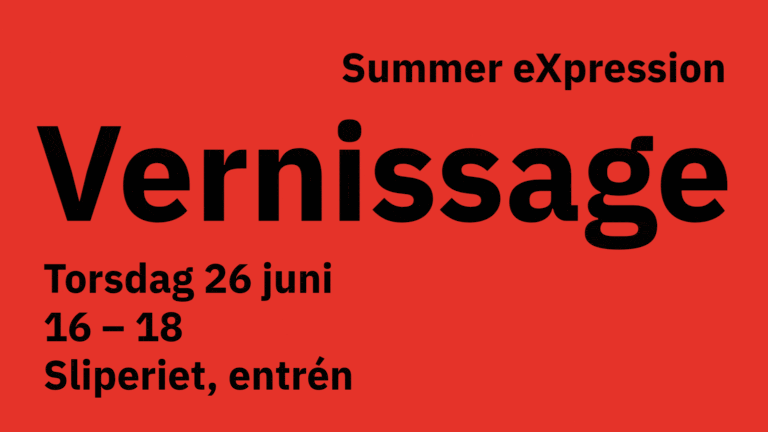I programmet eXpresssion Design tar deltagare fram produkter tillsammans med lokala tillverkare som slutligen går till försäljning. Men för Sara Rylander och Zandra Jungell Högberg har arbetet resulterat i alster med en tydlig konstnärlig framtoning. Vilka frågor och funderingar väcks i gränslandet mellan konst och produkt och går det att produktifiera ett konstnärligt uttryck?
Zandra Jungell Högberg och Sara Rylander är båda två deltagare i eXpression Design. De är också konstnärer.
Zandra är fotograf och bildkonstnär och har, efter att ha testat sig fram i programmet, landat i en bildskulptur av lagrat akrylglas – där skivan längst bak lyser igenom de övriga och skapar en 3D-effekt av motivet Natten (ett tidigare verk av Zandra).

Sara har en bakgrund inom slöjd. Med ett stort och långtgående intresse för fjärilar och insekter har hon i programmet återvänt, och på nytt utforskat dessa insekter konstnärligt, genom hantverkstekniken handtuftning. I hennes projekt har hon tagit fram larvmattan Turbulent Phosphila.

Skillnaden mellan konst och produkt
Gemensamt har de utmaningen i att överföra den konstnärliga processen till en affärsmässig kontext. Ett konstverk och en produkt har sina skillnader – det är i varje fall något som både Zandra och Sara menar.
– Givetvis kan en produkt vara vacker att titta på men det är något annat som är kärnan. Jag tänker att det är en funktion. I ett konstnärligt alster däremot är uttrycket och känslan som konstnären vill förmedla i fokus. Det kan vara något mer än en känsla, till exempel en åsikt, eller som i Saras fall, berättelser. Man lyfter på locket och sedan är det öppet för tolkning, säger Zandra.
Sara tar vid och tänker i samma bana.
– En produkt tillfredsställer någon form av konkret behov medan en konstnärlig gestaltning inte är lika tydlig. Eller det är på ett annat plan, möjligen tillfredsställer det ett emotionellt behov. Som konstnär vill jag ifrågasätta och utmana genom mina verk, säger Sara och fortsätter.
– Jag tycker att det är skillnad om man mångfaldigar för ett annat konstnärligt sammanhang eller om det rör sig om kommersiell massproduktion. Det är två helt olika saker.
– Jag tycker också att man kan hålla någon typ av gräns, fyller Zandra i. Blir det i för stor upplaga tappar de värde, men det kan ju få finnas mindre upplagor av något och sedan andra mer exklusiva verk.

Var exakt en sådan gräns går är svårt att avgöra menar både Sara och Zandra. Under programmets gång har deras egna processer stött på en del utmaningar av liknande karaktär – det vill säga att stå i gråzonen mellan konst och produkt.
– Min tanke var att skapa en produkt i början men i slutändan är det mer som ett konstverk. Jag tror att det är för att det är så jag är van att jobba. Det kommer inifrån och det är svårt att stoppa sig själv, säger Zandra.
Sara fyller i.
– Jag känner igenom mig jättemycket i det Zandra berättar. Den största utmaningen för mig varit att hitta ett lämpligt material och teknik som går att föra över till produkttänket. För att komma ner i pris behöver man hitta en rationell väg att gå.
– Ja, det är det som är så svårt men lika mycket lärorikt och intressant. Jag är van att inte behöva tänka att det behöver finnas en affärsmässig hållbarhet i det man skapar. Jag körde på som vanligt sen insåg jag att det här blir ju för dyrt, svarar Zandra.

En nyttig och lärorik process för framtiden
Det är långt ifrån säkert att allt kan eller bör kommersialiseras. Konst behöver få vara konst och i det få vara fri. Men utforskandet av gränslandet där konst och produkt sammanflätas fortsätter intressera de båda konstnärerna.
Den process som eXpression Design inneburit för Zandra och Sara har enligt de själva varit både rolig och nyttig.
– Jag tycker att det varit spännande att vara med i programmet, säger Sara Rylander. Inte minst för att nätverka och lära känna fler kreatörer. Som skapande människa drömmer jag om att skala på min verksamhet. Vad det är har för mig varit oklart. Men genom eXpression Umeå har jag fått möjlighet att testa vingarna som designer i kombination med mitt konstnärskap. Jag har en del att fundera vidare på.
– Det har varit otroligt lärorikt. Jag har inte insett alla steg som krävs för att ta sig igenom processen. Sen måste jag hålla med Sara. Att träffa andra kreatörer var en bidragande orsak till varför jag sökte till programmet. Den delen har också betytt väldigt mycket. Jag är glad för alla nya kontakter, avslutar Zandra Jungell Högberg.
Foto omslagsbild: Johan Gunseus och Elin Nerpin.
» eXpression Design 20/21: Ta del av alla produkter, reportage och information här






